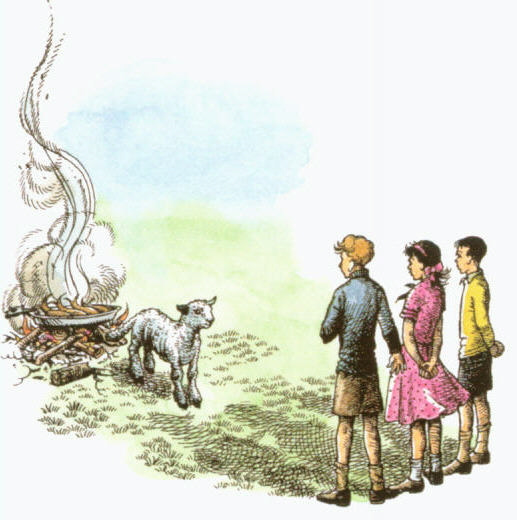Meeting Aslan Beyond the Edge of the World
The Gospel according to John and The Voyage of the Dawn Treader
I’m a seasonal reader. Books go with seasons, hence why we picked the summer feel of The Voyage of the Dawn Treader for our family vacation car trip last week. In the third Narnia book, The Voyage of the Dawn Treader, Prince Caspian now King of Narnia seeks the lost lords that sailed east under his uncle’s reign. Exploration and adventures on the high seas is exciting. It is a great summer read. However, the depth of the book is rich and beautiful. It moves me every time. The end is heavenly, pun intended! Why? Because it is filled with picture from the Gospel according to John.
The final chapter finds King Caspian longing to reach Aslan’s country, but ordered not to go by Aslan, himself. Edmund, Lucy, and their cousin Eustace must go further. They are accompanied by Reepicheep, the valiant mouse, whose dearest dreams throughout the book are to come to Aslan’s country. Lewis introduced Narnian readers to the fact that Aslan is the son of the Emperor-Over-the-Sea in The Lion, the Witch, and the Wardrobe. By the end of the voyage, the reader gets a glimpse of that far off country.
Edmund, Lucy, and Eustace, come upon a sandy beach at the very end of the world. As their eyes adjust, they behold a Lamb inviting them. “Come and have breakfast,” said the Lamb in its sweet milky voice. Behind the Lamb, the children see a fire lit and fish roasting. Mirroring the Gospel according to John in chapter 21, Christ walks on the shore of the Sea of Tiberias and calls out to the disciples if they have any fish. Jesus the Son of God tells them to cast their nets to the right side of the boat, allowing the disciples to catch a staggering amount of fish; Peter declares that it is the Lord. When Peter arrives on the shore, there is fire going, ready for the fish. Christ welcomes them, “Come and have breakfast” (John 21:12).
The Lamb tells the children that for them Aslan’s country must be entered not through Narnia, but through their own country, England. Here, Aslan reveals himself, changing from the Lamb to his well-known form of the Lion. With little room for subtly here, Lewis is reflecting on the language of Christ as the Lamb of God (John 1:29) and the Lion of Judah (John 1:29, Revelation 5:5-6).
Aslan tells Lucy and Edmund that this is their last time in Narnia and that they must be close to their world now. He will be telling them how to get to his country from their world, but it requires a great bridge. However, he is the great Bridge Builder. Perhaps a play on the “I AM” statements of Christ through John’s Gospel (two candidates could be, “I AM the gate/door, or I AM the way?).
In one of my truly favorite moments, Lucy cries, and states, “It isn’t Narnia, you know… It is you. We shan’t meet you there. And how can we live, never meeting you?” Aslan puts her fears to rest that he will be there. His confirmation to Edmund (note the “I am”) is Lewis at his best and with his cards completely on the table.
“Are—are you there too, Sir?” said Edmund. “I am,” said Aslan. “But there I have another name. You must learn to know me by that name. This was the very reason why you were brought to Narnia, that by knowing me here for a little, you may know me better there.”
The Pevensie children are known by and know the great I AM (John 8:58). Eustace’s mother upon his arrival back complains that he now seemed, “commonplace and tiresome.” His cousins receive the blame. But Eustace is no longer dragonish due to Aslan. The undressing and reclothing of Eustace’s dragon scales by Aslan reminds me of the blind man in John 9 — “I don’t know. One thing I do know: I was blind, and now I can see.”
Lucy asks before they are sent back to England if Eustace will come back to Narnia. “Child,” said Aslan, “do you really need to know that?” As the Gospel of John ends, Peter sees “the disciple Jesus loved following them.” It is John following them, which leads Peter to ask Jesus what about that disciple (remember Peter was charged 3 times in the preceding verses). Christ responds, “If I want him to remain until I come, what is it to you? As for you, follow me.”


